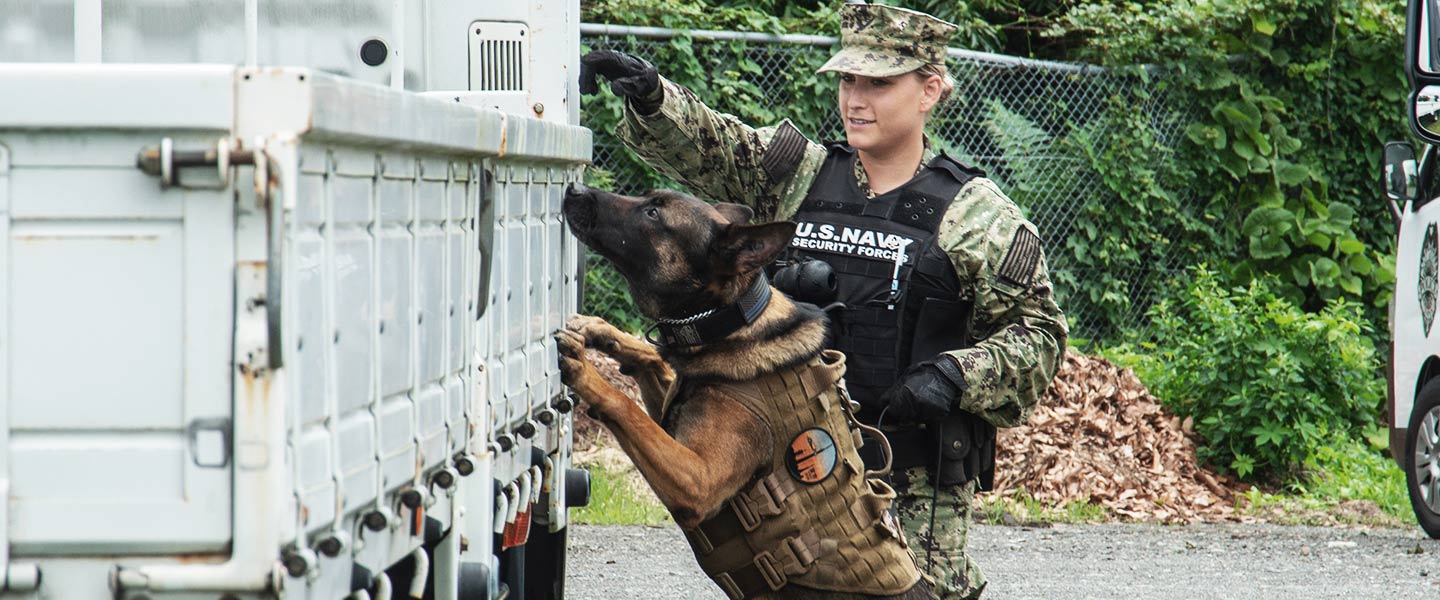What to Expect
More Information
Responsibilities
The law enforcement and security community provides a wide range of critical services to every part of the Navy. As a Master-at-Arms you may:
- Provide security and physical protection for service members
- Train fellow Sailors in security and shore patrol duties
- Serve as a security advisor for your squadron
- Assist in crowd control and riot prevention
- Operate military prisons (brigs) aboard ships and on shore
- Handle and care and training for dogs that detect narcotics and explosives
- Conduct waterborne security patrol and interdiction operations
- Provide protective service to high-ranking dignitaries and government officials
- Conduct preliminary investigations into Uniform Code of Military Justice violations
- Conduct crime prevention programs
Work Environment
As an Enlisted Sailor working in law enforcement, you will have the chance to work in a number of environments. Though sometimes you may work behind a desk, you will often be out interacting with the community in a law enforcement capacity. You can expect to work at shore stations in the United States and overseas, aboard ships or as part of a maritime security squadron. In short, your assignments could take you anywhere in the world.
Training & Advancement
Upon completion of initial Recruit Training (known as Boot Camp), those pursuing a Law Enforcement & Security role will report to San Antonio, TX, where they will receive formal Navy technical training at “A” School for about 9 weeks. Here, they will learn antiterrorism techniques, armed sentry/post standing techniques, crime prevention, military and civil law, communications, first aid, firearms deployment and physical restraint techniques.
Promotion opportunities are regularly available but competitive and based on performance.
Post-Service Opportunities
It’s also important to note that specialized training received and work experience gained in the course of service can lead to valuable credentialing and occupational opportunities in related fields in the civilian sector.
Education Opportunities
Beyond offering access to professional credentials and certifications, Navy technical and operational training in the field of Law Enforcement & Security can translate to credit hours toward a bachelor’s or associate degree through the American Council on Education.
You may also continue your education through undergraduate degree opportunities like the Navy College Program and Tuition Assistance and the Post-9/11 GI Bill.
Qualifications & Requirements
A high-school diploma or equivalent is required to become an Enlisted Sailor in law enforcement and security. Those seeking a Master-at-Arms position should be people-oriented, dedicated, resourceful and versatile. They should also possess physical strength, manual dexterity and be competent with tools and equipment. Citizenship requirements may vary.
General qualifications may vary depending upon whether you’re currently serving, whether you’ve served before or whether you’ve never served before.
Part-Time Opportunities
Serving part-time as a Navy Reserve Sailor, your duties will be carried out during your scheduled drilling and training periods. During monthly drilling, Masters-at-Arms in the Navy Reserve typically work at a location close to their homes.
For annual training, Masters-at-Arms may serve anywhere in the world—on ships or at bases and installations. Take a moment to learn more about the general roles and responsibilities of Navy Reserve Sailors.
Most of what you do in the Navy Reserve is considered training. The basic Navy Reserve commitment involves training a minimum of one weekend a month (referred to as drilling) and two weeks a year (referred to as Annual Training) – or the equivalent of that.
Masters-at-Arms in the Navy Reserve serve in an Enlisted role. Before receiving the ongoing professional training that comes with the job, initial training requirements must be met.
For current or former military Enlisted servicemembers: prior experience satisfies the initial Recruit Training requirement – so you will not need to go through Boot Camp again.
For those without prior military experience: you will need to meet the initial Recruit Training requirement by attending Boot Camp in Great Lakes, IL. This training course will prepare you for service in the Navy Reserve and count as your first Annual Training.

































































































































